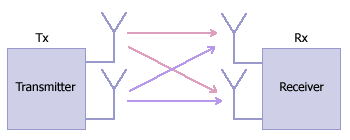Introduction to Multiple Antenna Systems: SIMO, MISO, MIMO
MISO

Picture. Multiple Input Single Output (MISO), 2x1
Two antennas at the transmitter, one antenna at the receiver.
Employs a transmit diversity technique.
A system which uses multiple antennas at the transmitter and a
single antenna at the receiver is named Multiple Input Single
Output (MISO). A technique known as Alamouti STC (Space Time
Coding) is employed at the transmitter with two antennas. STC allows the transmitter to transmit signals (information) both
in time and space, meaning the information is transmitted by
two antennas at two different times consecutively.
Multiple antennas (each with an RF chain) of either SIMO or
MISO are usually placed at a base station (BS). This way, the cost
of providing either a receive diversity (in SIMO) or transmit
diversity (in MISO) can be shared by all subscriber stations (SSs)
served by the BS.
MIMO
To multiply throughput of a radio link, multiple antennas (and
multiple RF chains accordingly) are put at both the transmitter
and the receiver. This system is referred to as Multiple Input Multiple
Output (MIMO). A MIMO system with similar count of antennas at
both the transmitter and the receiver in a point-to-point (PTP)
link is able to multiply the system throughput linearly with every
additional antenna. For example, a 2x2 MIMO will double the
throughput.

Picture. Multiple Input Multiple Output (MIMO), 2x2
Two antennas at both the transmitter and the receiver.
MIMO often employs Spatial Multiplexing (SM) to
enable signal (coded and modulated data stream) to be transmitted
across different spatial domains. Meanwhile, Mobile WiMAX supports multiple
MIMO modes, that's using either SM or STC or both to maximize spectral
efficiency (increase throughput) without shrinking the coverage
area. The dynamic switching between these modes based on channel
conditions is called Adaptive MIMO Switching (AMS). If combined
with AAS (Adaptive Antenna System), MIMO can further
boost WiMAX performance.
MIMO is a hot topic in today wireless communications since all wireless
technologies (PAN, LAN, MAN, and WAN) try to add it to increase data rate multiple times
to satisfy their bandwidth-hungry broadband users.
|